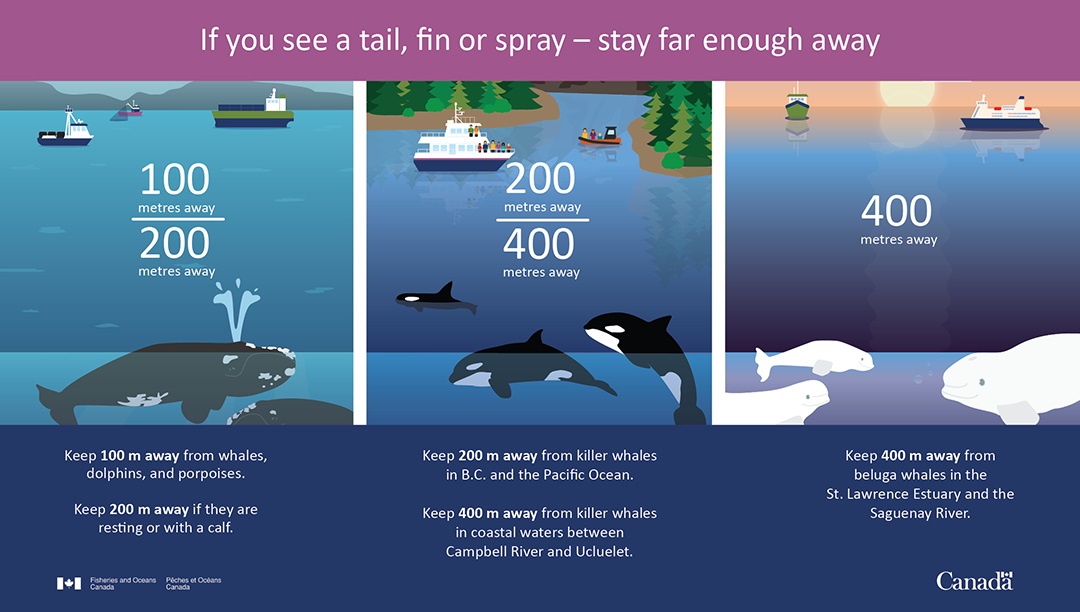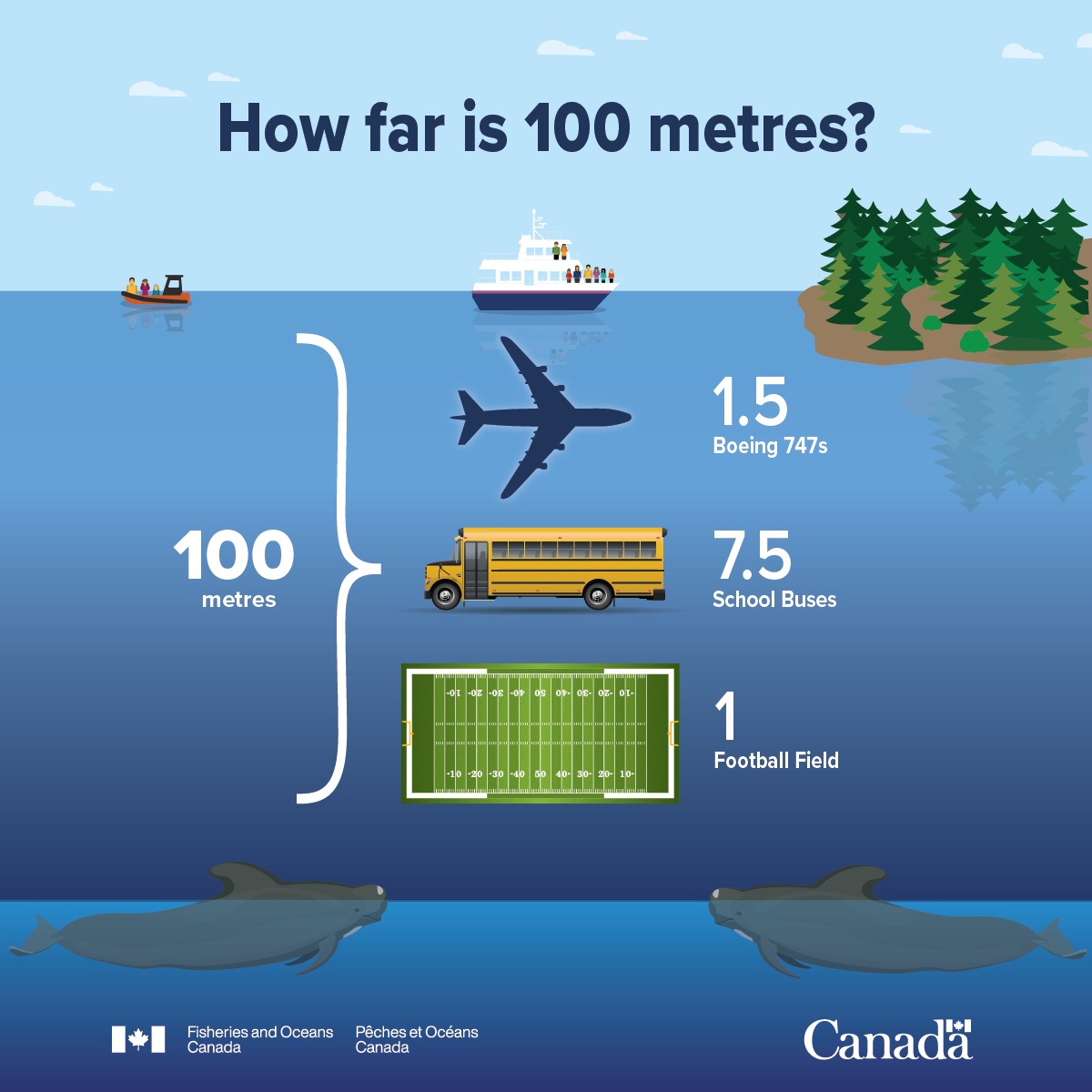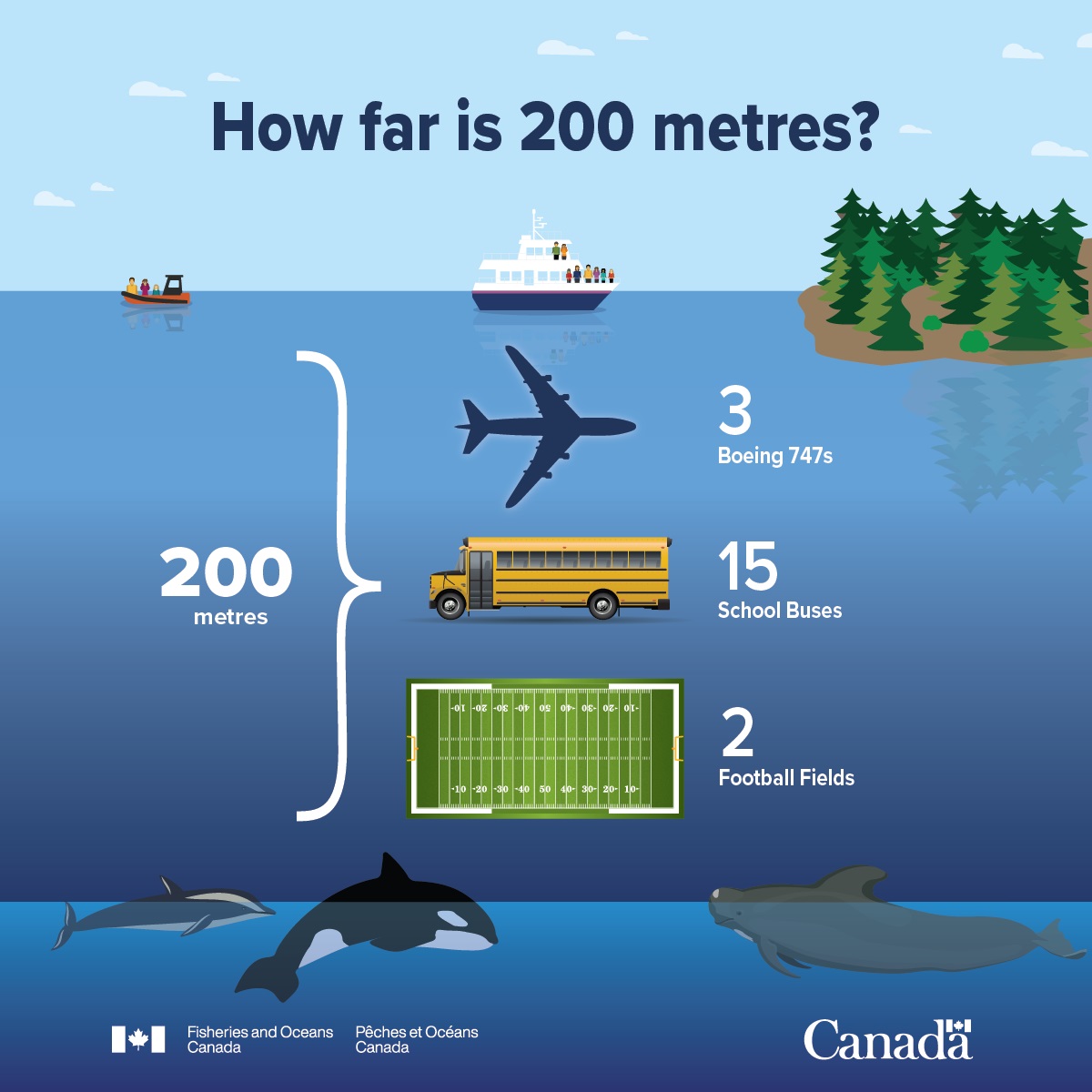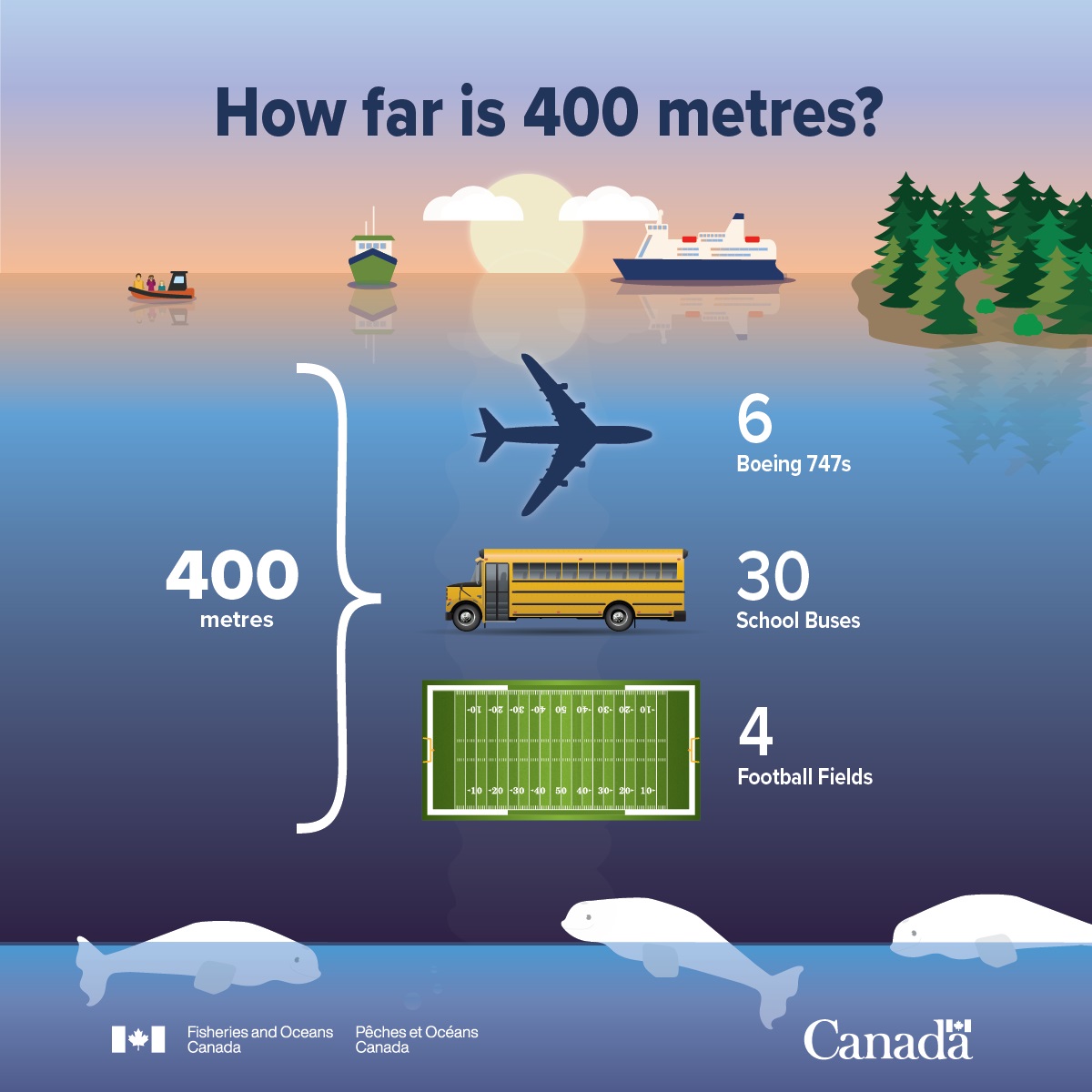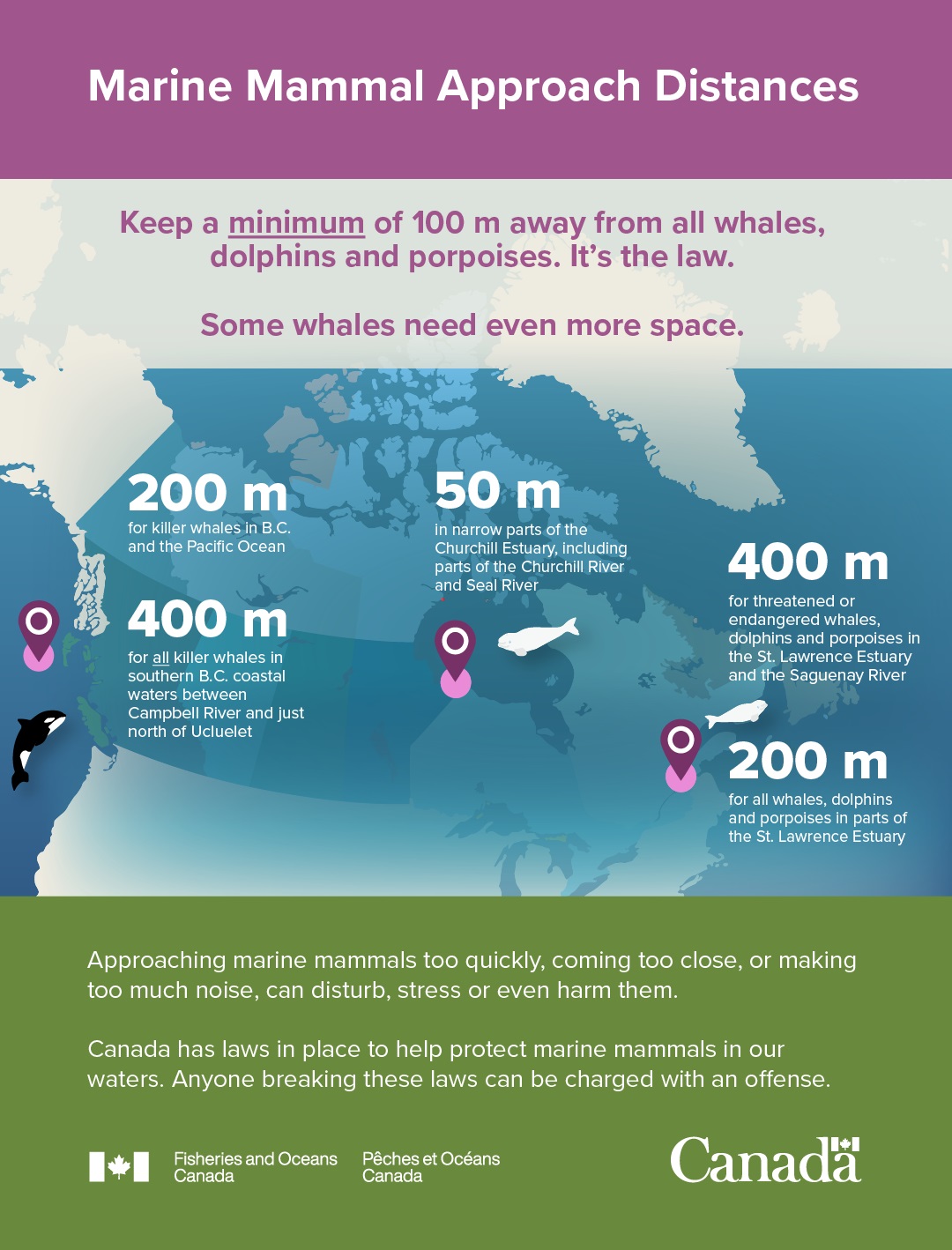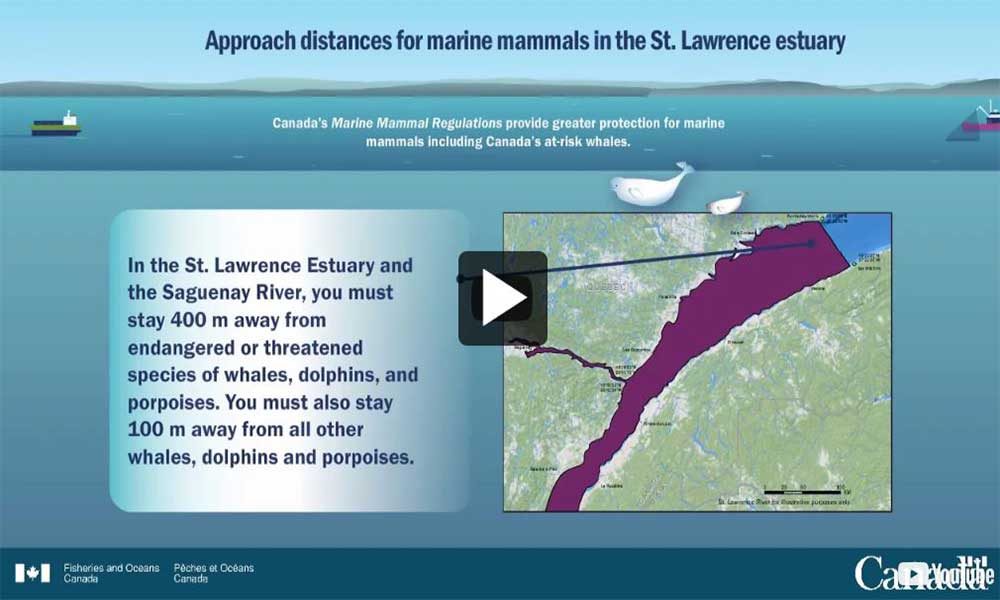Watching marine wildlife
To report a marine mammal disturbance or harassment
Please visit Report a Sighting or Incident.
On this page:
- Laws and regulations
- Approach distances
- Viewing marine mammals from the air
- How to avoid disturbing marine mammals
- Related links
Watching whales and other marine mammals in their natural surroundings helps us to better appreciate these beautiful animals. When humans get too close to wildlife in their habitat, we risk disturbing and even harming them. There are laws and guidelines about marine mammals to protect their well-being and yours.
In Canada, it’s against the law to disturb a marine mammal. You can’t:
- feed, swim or interact with a marine mammal
- move a marine mammal (or entice/cause it to move)
- separate a marine mammal from its group or go between it and a calf
- trap a marine mammal or a group between a vessel and the shore, or between a vessel and other vessels
- tag or mark a marine mammal
Laws and regulations
Canada’s laws and regulations help ensure whales and marine mammals can still be enjoyed, but at a safe distance. Approaching marine mammals too quickly, coming too close or making too much noise can disturb, stress or even harm these wonderful creatures who call our waters home.
Species at Risk Act
The Species at Risk Act (SARA) is part of the Government’s commitment to keep Canadian wildlife species from becoming extinct and take the necessary actions for their recovery. It provides for the legal protection of wildlife species and the conservation of their biological diversity.
Marine Mammal Regulations
All marine mammals are subject to the provisions of the Marine Mammal Regulations under the Fisheries Act. The Government of Canada amended the Marine Mammal Regulations in 2018 to provide greater protection for marine mammals including Canada’s at-risk whales.
Approach distances
Keeping a minimum distance is the law. Getting too close could result in charges under the Fisheries Act, with fines up to $100,000.
Canadian waters in general
- Keep at least 100 metres away from whales, dolphins and porpoises
- Keep at least 200 metres away from whales, dolphins and porpoises that are resting or with a calf
The distance requirement is greater for certain marine mammals because of the threats they already face. The minimum approach distances below are based on the best available science.
Killer whales in British Columbia and the Pacific Ocean
- Keep 200 metres away from all killer whales in British Columbia (B.C.) and the Pacific Ocean
- Keep 400 metres away from all killer whales in southern B.C. coastal waters between Campbell River and just north of Ucluelet (June 1 to May 31)*
*Under the Canada Shipping Act
Narrow Churchill and Seal River areas
- Keep 50 metres away from whales, dolphins and porpoises in narrow parts of the Seal and Churchill River estuaries
- Keep 100 metres away from whales, dolphins and porpoises in all other areas
St. Lawrence estuary
- Keep 400 metres away from whales, dolphins and porpoises that are listed as endangered or threatened under the Species at Risk Act
- This includes beluga whales, blue whales and North Atlantic right whales
- Keep 200 metres away from whales, dolphins and porpoises that are not endangered or threatened in certain parts of the St. Lawrence Estuary (between Isle-aux-Grues and Baie-Comeau on the north side of the Estuary and Baie-des-Sables on the south side)
- Keep 100 metres away from all whales, dolphins and porpoises in all other areas of the estuary.
Saguenay St. Lawrence Marine Park and the Saguenay River*
- Keep 400 metres away from whales, dolphins and porpoises that are listed as endangered or threatened under the Species at Risk Act in the Saguenay-St. Lawrence Marine Park
- Keep 100 metres away from whales, dolphins and porpoises in all other areas of the Saguenay River.
*Under the Marine Activities in the Saguenay–St. Lawrence Marine Park Regulations
Viewing marine mammals from the air
The noise and presence of aircraft (including drones) can disturb wildlife both in the water or on land.
When an aircraft is being operated at an altitude of less than 304.8 metres (1,000 feet) within a radius of one-half nautical mile from a marine mammal, it cannot perform a flight manoeuvre. A flight manoeuvre includes taking-off, landing or altering the course or altitude of the aircraft. This is to prohibit the purpose of bringing the aircraft closer to the marine mammal or otherwise disturbing it.
Drones are discouraged for viewing marine mammals unless appropriate permits are obtained. For more information on licensing and permitting, please visit:Application instructions for the authorization of marine mammal disturbance.
How to avoid disturbing marine mammals
In addition to keeping your distance (as per the laws and regulations), boaters, harvesters and paddlers are encouraged to follow the voluntary guidelines when in the presence of whales and other marine mammals.
For their safety and yours:
- use binoculars to watch marine mammals from a safe distance
- move away slowly and cautiously at the first sign of disturbance or agitation from the animal
- stop fishing in the presence of marine mammals, but don’t haul up your gear
- hauling gear could cause depredation, a learned behaviour where marine mammals associate fishing gear with food
When watching whales
- be on the lookout for blows and other indicators of whale presence
- slow down and reduce your speed to less than 7 knots when within 1 kilometre of whales
- don’t approach them if there are already several boats present
- don’t approach them head on or from behind, as this will cut off their movements
- only approach and depart from the side, moving parallel to the direction of the animal’s travel
- avoid changing directions quickly or parking your boat in their path
- limit your view time to 30 minutes or less
- stay on the offshore side of the whales when traveling close to shore
- if a whale approaches you in the water, move away or turn your engines to neutral idle when safe to do so
- turn off echo sounders and fish finders when not in use and safe to do so
Porpoises and dolphins
If dolphins or porpoises ride the bow wave of your boat, avoid sudden course changes. Hold course and speed or reduce speed gradually.
Seals, sea lions and walruses
When you encounter seals, sea lions or walruses:
- reduce boat speed, minimize wake, wash and noise, and then slowly pass without stopping
- ‘wake’ is the disturbed water caused by the motion of a boat’s hull passing through the water
- ‘wash’ is the disturbed water caused by the propeller or jet drive
- avoid sudden changes of speed or direction
- move away slowly at the first sign of disturbance or agitation
- if the animal starts to stare, fidget or dive into the water, you are too close
- be cautious and quiet near haul-outs, areas where marine mammals come onto land or ice, especially during breeding and pupping seasons when they give birth (generally May to September).
Beached seal pups
If you see a young seal that seems to be alone and in distress, keep your distance and your pets leashed, as its mother is probably nearby. Seals normally spend long hours out of the water resting and should not be disturbed.
For more information on the best ways to help whales and all marine mammals while on the water, please visit bewhalewise.org.
Related links
Quebec partners
- Eco-Whale Alliance
- Mingan Island Cetacean Study
- Comité ZIP de la rive nord de l’estuaire (in French only)
- Réseau d’observation de mammifères marins (in French only)
British Columbia partners
- Ocean Wise Sightings Network
- Robson Bight Ecological Reserve
- Cetus Research and Conservation Society
- Be whale wise
- Marine Education and Research Society: See A Blow Go Slow
International partners
- The Whale Museum
- National Oceanic and Atmospheric Administration (NOAA) Fisheries
- Date modified:
